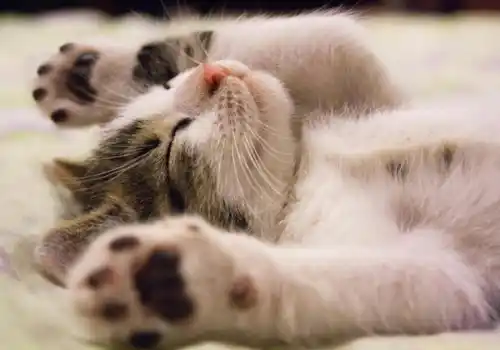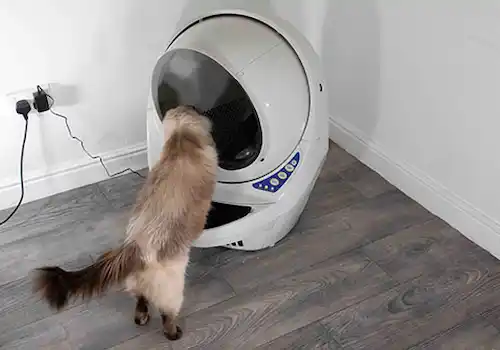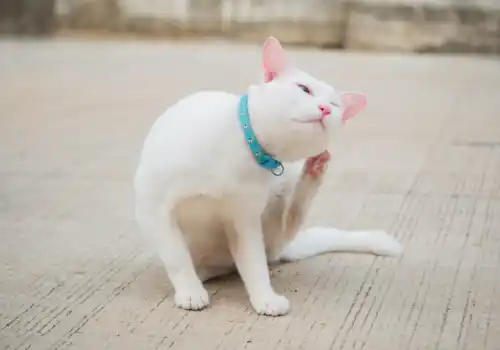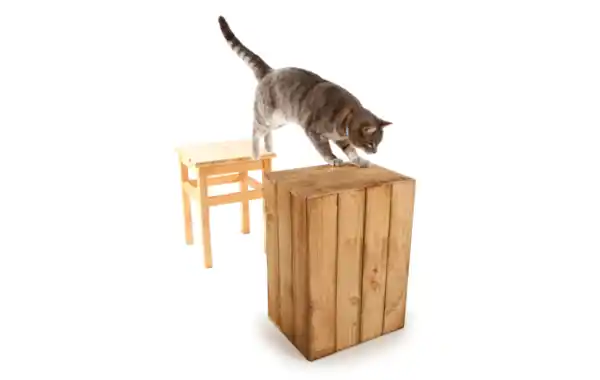How to teach our cats to play, exercise and bond with us - for fun and for fitness!
In 12 previous cat training features, we have shown you how to carry out many of the basic tasks you need to do to keep your cats happy and healthy in a way that teaches them that such tasks can be acceptable and pleasant. No longer should the sight of the cat carrier send your cat running away, but instead actively moving towards it as he associates being inside the carrier with a tasty treat. Likewise, being examined at the vets need no longer be a scary experience but one associated with your cat feeling in control and anticipating nice things.
Many of these training tasks may take lots of time and if you have not yet mastered all of them with your cat, do not give up; instead, keep working at your own cat's individual pace, setting yourself small achievable goals to work within.
Now we'll be showing that some of the training tools we have used to teach our cats everyday tasks in a more feline-friendly way can be used to help you have fun with your cat, improve his fitness, provide mental stimulation and cement your bond with him.
By nature, cats are solitary hunters designed to catch small prey. This involves spending a significant part of their day hunting and consequently eating small amounts of food frequently. In addition, much time will be spent exploring their territory using highly-developed senses and athletic abilities.
In our pet cats, such hunting and explorative instincts have not disappeared and while many do not actively hunt, the desire to perform such behaviours still exists. For many other cats, outside access is restricted or not available so hunting and outdoor exploration opportunities are not possible. As a consequence, alongside over feeding, many pet cats are overweight.
So, to ensure your cat's needs are met and he maintains optimum physical and psychological health, you can provide opportunities for exercising both his body and mind by encouraging some of the behaviours usually observed during predatory and explorative behaviour through fun training games.

Creating the perfect playground
Starting within the home, think of things you could possibly use to encourage your cat to become more active. Are there pieces of furniture that are close enough together so your cat can jump from one to another? Do you have any cardboard boxes he can jump in and out of? Perhaps you have shelves your cat can walk along? We so often only allow our cats floor space, but they like to utilise vertical space just as much as horizontal space.
Think back to our first articles where we described how cats learn and the training tools we can use (parts 1, 2 and 3 of this series). We will be using many of these principles in the following games - in particular, we'll use lots of luring. In short, this is where you'll need to move one of your cat's favourite rewards in a manner that gets him to follow it.
Move the reward to your desired location and give your cat the reward when he gets there. So, for example, if you wish for your cat to jump from one object to another, use a wand or fishing rod-style toy and move it from one object to the other so he follows. When he reaches the second object, let him play with the toy.
Begin with the two objects almost touching so that your cat simply has to walk from one to other, then gradually move them apart so that your cat has to step across the gap, then move again so that he has to jump. By moving objects in this way, you are gradually building up the amount of exercise and mental effort your cat has to exert to reach his reward.
As well as toys, small food treats can also be used. Initially you may move these in front of your cat's nose, but after several repetitions you should be able to place one on the first object to get your cat to jump onto it, and then another on the next object and so on.
After many repetitions of this, you can introduce a cue before placing the reward - for example, tapping your fingers on the final destination object and then immediately placing the treat. Your cat will soon learn that the tap means a reward will occur there and will learn to move after seeing or hearing just the tap of the fingers.
At this stage, you can intermittently reward (not every time you ask your cat to jump does he need a food reward or access to a toy) - he should find the game of jumping from one piece of furniture to another fun and rewarding in itself. Remember, the best way to play such games is frequently for short durations.
As well as jumping between objects, you can teach your cat to go through tunnels, jump in and out of cardboard boxes, and search for hidden treats in scrunched-up paper in boxes or under plastic tubs. Also, a good game that can utilise all of the space in the house is hiding your cat's dry food or cat treats around the house and tapping your fingers at those hidden locations until your cat learns to start looking for the rewards himself. Such activities will really engage his brain as well as his body, helping to keep him fit and occupied.

Garden games
For cats that have outdoor access, playing games in the garden can help create a bond between you both outside and create a really positive association with the garden, which may help your cat stay close to home as that is where exciting things happen.
It is now possible to buy agility-like equipment for cats, but such objects can just as easily be made. Tunnels, jumps and poles to run through can all provide excellent exercise for your cat (as well as exercise for you if you're running around with a toy to lure your cat over jumps!).
Remember to give your cat time to explore any new equipment before encouraging him to use it. Allow him to sniff and facial-rub on it in his own time and reward such behaviours with praise, food treats and/or toys.
Special considerations
For cats who are very overweight, ensure your chosen tasks involve minimal physical activity to allow your cat to build up fitness. Place jumping objects close together, and for kittens or elderly cats, ensure objects are close to the ground and stable.
If you have a cat with mobility problems such as arthritis, which makes jumping painful and sometimes difficult, stick to less physical tasks such as practising the skills you used in mat training (see parts 1 and 2), using a new marker instead of your mat and moving this around the garden. For cats with any medical conditions, it's a good idea to consult your vet before undertaking any of the fun and fitness training.
Remember as you carry out these fun games, see how many of the tools you use that were developed during your previous training tasks. For example, does luring your cat through the play tunnel remind you of cat flap training? Does encouraging your cat to jump into a cardboard box remind you of cat carrier training? Through fun and games, we can practise many of the skills we need for the more serious tasks, thus making them even more likely to be easy for your cat to master - and enjoyable at the same time.








